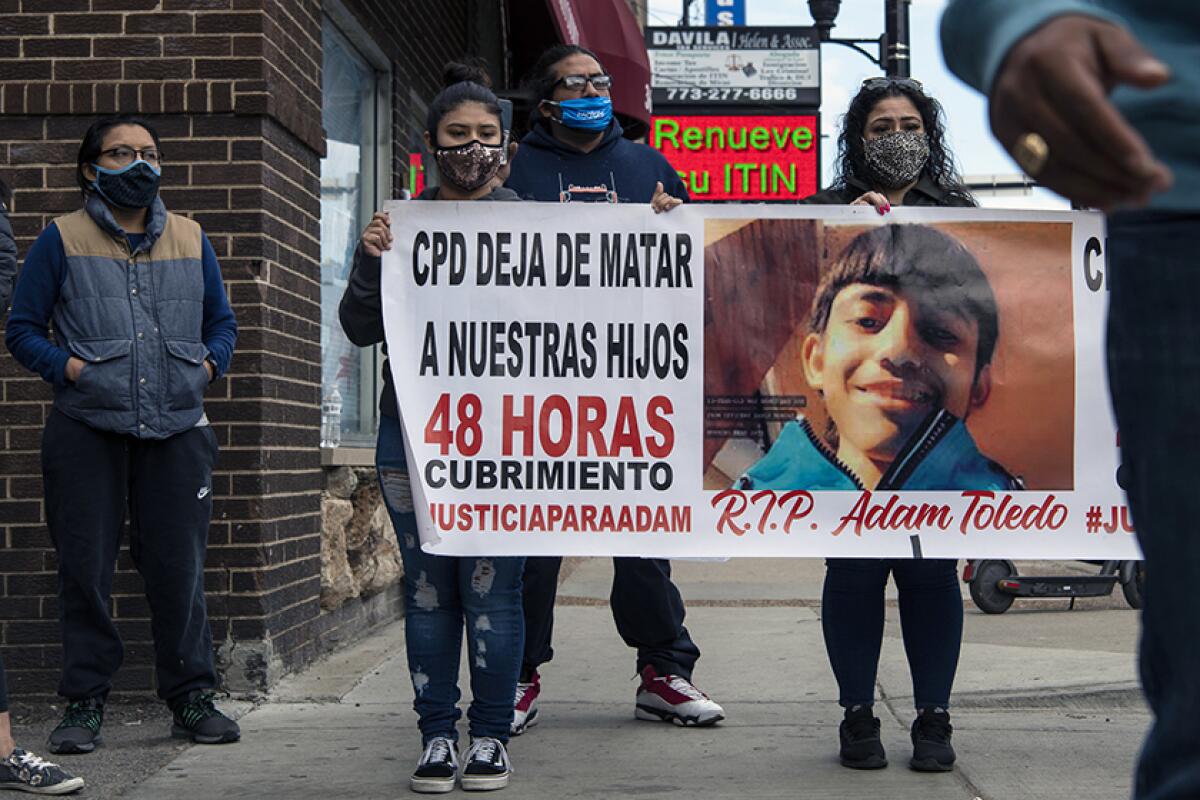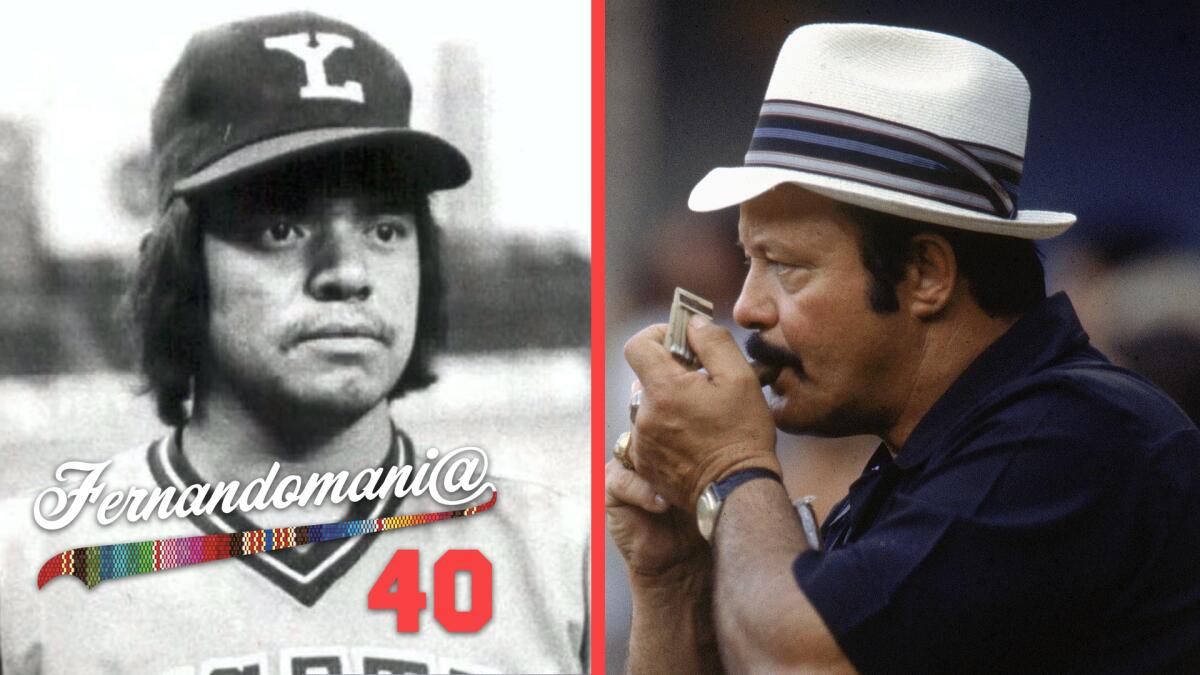Latinx Files: After George Floyd verdict, will Adam Toledo’s family get justice?

- Share via
Adam Toledo was a child. He was also unarmed and had his hands up when he was shot and killed by Chicago police in the predominantly Latinx neighborhood of Little Village on March 29.
These are two tragic and irrefutable facts. The latter was confirmed when body-camera footage was released, immediately rendering false a statement made by a Chicago prosecutor who has since been placed on leave.
It won’t matter though. That Adam had a gun in the first place will be used to justify his death. I can’t see into the future, but I’ve lived long enough to know how this story will unfold. If he’s charged, Officer Eric Stillman will claim that he feared for his life as reason for killing the 13-year-old boy. He’ll be given the benefit of the doubt, a luxury that won’t be afforded to Adam.
“A 13-year-old should not be on the street at 2:30 a.m. with a gun,” Fernando Serrano, a Puerto Rico-born father of three who lives in the area, told my colleague Molly Hennessy-Fiske. “It could happen again tonight. There are parents worse off.”
Though there have been protests and calls for the resignation of Mayor Lori Lightfoot — she ran on the promise of police reform but has yet to deliver — some people have already used the presence of a weapon at the scene as reason to blame Adam for his own death. María Inés Zamudio of WBEZ in Chicago reported that Elizabeth Toledo, Adam’s mother, received upsetting messages in the aftermath of her son’s death.
“She’s been getting messages from the community that the community is judging her,” said Adeena J. Weiss-Ortiz, an attorney for the family. “She wants you to know she was a full-time mom and a homemaker to five children. That on Sunday night she put her son to bed with his little brother.”
The Latinx experience chronicled
Get the Latinx Files newsletter for stories that capture the multitudes within our communities.
You may occasionally receive promotional content from the Los Angeles Times.
Rather than be allowed to mourn, Elizabeth Toledo has had to defend her parenting as if she’s the one who pulled the trigger. Her son might have been out late at night and might have fallen in with the wrong crowd, but he didn’t need to die.
I always think the police using the phrase “fear for my life” after a deadly encounter is some kind of sick joke because that’s precisely how I would characterize any potential interaction with police.
In a piece on Daunte Wright, who was shot and killed by an officer who alleged to have confused her gun for a Taser, opinion columnist LZ Granderson recalled buying a “Golden Girls” mask to make his 6-foot-2 Black body less threatening to white Americans. The sad reality is you can be a person of color and an upstanding citizen, and still end up dead after an interaction with police.
It’s possible that I could be proved wrong about what’s going to happen here. Who knows — Officer Stillman might end up being held accountable just like Derek Chauvin, who was found guilty Tuesday of murdering George Floyd.
I’m not optimistic, though. It took definitive video evidence and a summer of protest and racial reckoning for Floyd to get justice, and even then people weren’t sure it was going to happen. Until America changes the way it does policing, Chauvin will continue to be the exception rather than the rule.
Consider subscribing to the Los Angeles Times
Your support helps us deliver the news that matters most. Become a subscriber.
Watch the second episode of “Fernandomania @ 40”

The Times is releasing today the second episode of our multipart series on the 40th anniversary of Fernandomania, which saw Mexican pitcher Fernando Valenzuela become an overnight icon for the Dodgers and forever changed the makeup of the team’s fandom.
In Part Two, we learn more about Valenzuela’s journey from pitching in the Mexican League to ending up with the Dodgers. Perhaps most importantly, this is the first episode to feature an interview with Valenzuela himself.
You can find the first episode and subsequent ones in our Fernandomania section. And while you’re there, you should read Dylan Hernández’s column on why Valenzuela deserves to be in the Baseball Hall of Fame even if he doesn’t have the career numbers for enshrinement at Cooperstown.
Meet our Latinx staff: Angie Orellana Hernandez
The Los Angeles Times employs more than 100 Latinx journalists. One of the goals of this newsletter is for you to meet them all. This week, we highlight Angie Orellana Hernandez, who just started her internship with the arts and entertainment desk and talks about her pride in being Guatemalan.
Some basic stuff about me: I’m a junior majoring in journalism and Spanish at USC, my hometown is Sacramento, and I wish I could hang out with Rigoberta Menchú Tum.
I’m also Guatemalan, from the land of eternal spring.
But for the longest time, I didn’t want to be associated with Guatemala. When I immigrated to California at 5 years old, I remember being asked by my classmates where my family was from. I’d say Guatemala; they’d say, “What’s that?” So I would freeze and say, “Oh, it’s like Mexico.” Then they understood.
Fast-forward, my eighth-grade science teacher asked the class which race or ethnicity they thought made up the largest demographic at the school. Everyone in the class guessed white, and when the teacher said that was incorrect, the class tried again. They yelled out, in unison, “Mexican!”
Keep in mind, I was a shy kid in middle school, and I rarely spoke up during class. But fueled by my frustration and eagerness to correct everyone, I raised my hand and said Mexican was not a race; it’s a nationality, and the correct term was “Latino.” My teacher agreed, but from the back of the class, I remember snarky laughs and the murmur “why is she so mad?”
So, where am I getting with all of this? The point is simple: Central Americans and Afro Latinx folk have been constantly erased by a world that shifts more and more toward Mexican hegemony. When considering the Latinx identity, think about who you’re really including and who you are leaving out. To be Latinx is to be Guatemalan, Salvadoran, Nicaraguan, Garífuna, Belizean and more. Not just Mexican.
Things we read this week that we think you should read
— From the “where are they now” department comes this entertaining and wonderful follow-up on Dan Pena, a cantankerous Chicano who lives in a Scottish castle after striking it rich in oil and finance. Pena was profiled in The Times back in 1983 in a story on wealthy Latinxs written by Al Martinez, which was part of the paper’s “Latinos” series that won the Pulitzer Prize for public service the next year.
A fun note: Column One editor Steve Padilla tells me that Pena reached out to the paper after learning that “Latinos” had been digitized. The story was eventually assigned to reporter Louis Sahagún, who is one of two staffers who worked on the series and are still at The Times (the other is business editor Nancy Rivera Brooks). All of this to say that if you haven’t read it yet, do yourself a favor and check it out.
— The Los Angeles Times is launching a daily podcast appropriately called “The Times.” It launches May 3 and will be hosted by columnist Gustavo Arellano, who gives you a little preview of what to expect.
— Speaking of podcasts, last week would have been Selena Quintanilla’s 50th birthday, and to commemorate the occasion the “Anything for Selena” podcast put out a bonus episode in which host Maria Garcia interviews Chris Perez, the Tejano singer’s widower.
— El Salvador has some of the world’s harshest abortion laws. Women can be jailed for having miscarriages, stillbirths and other obstetric emergencies. My colleague Julia Barajas reported on a lawsuit filed with the Inter-American Court of Human Rights that could force the Central American nation to revise this practice.
— LAist profiled Sonia Romero and Kristy Sandoval, two L.A.-based muralists doing great things in a field dominated by men.
The best thing on the Latinternet: The week that Bad Bunny made us all curse ‘la maldita pobreza’
The pandemic robbed us of the chance to hear Bad Bunny’s “YHLQMDLG” and “El Último Tour del Mundo” at the club, and now capitalism has robbed many of you of seeing the Puerto Rican pop megastar in concert. I say “you” because I didn’t even bother trying. (Insert Roll Safe meme here.) You can’t be disappointed if you don’t try.
Tickets for Bad Bunny’s tour went on sale last week, and just about anyone who tried to buy them ended up getting nothing but a huge, fat L. As my colleague Christi Carras pointed out in the headline to her story, getting a vaccine appointment was a lot easier for many than securing tickets. Fans can still get tickets in the resale market, but unless Joe Biden plans to give out another round of stimulus checks, the sad reality is many of y’all aren’t going.
My timeline was filled with tweets of Latinxs memeing their pain away. My personal favorite was this video made by TikToker Leo Gonzalez, whom I mentioned in the “future of Latinx television” edition of this newsletter.
The Latinx experience chronicled
Get the Latinx Files newsletter for stories that capture the multitudes within our communities.
You may occasionally receive promotional content from the Los Angeles Times.







